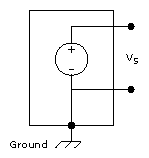Grounded Signal Sources
A grounded source is one in which the voltage signals are referenced to a system ground, such as earth or building ground, as shown in the following figure.

Because such sources use the system ground, they share a common ground with the measurement device. The most common examples of grounded sources are devices that plug into the building ground through wall outlets, such as signal generators and power supplies.
 |
Note The grounds of two independently grounded signal sources generally are not at the same potential. The difference in ground potential between two instruments connected to the same building ground system is typically 10 mV to 200 mV. The difference can be higher if power distribution circuits are not properly connected. |
Measuring Grounded Signal Sources
A grounded signal source is best measured with a differential or an NRSE measurement system. If you use an RSE measurement system with a grounded source, the result is typically a noisy measurement system often showing power-line frequency (60 Hz) components in the readings. Ground-loop introduced noise can have both AC and DC components, introducing offset errors and noise in the measurements. The potential difference between the two grounds causes a current to flow in the interconnection. This current is called ground-loop current.
However, you can still use an RSE measurement system if the signal voltage levels are high and the interconnection wiring between the source and the measurement device has a low impedance. In this case, the signal voltage measurement is degraded by ground loop, but the degradation may be tolerable. You must observe the polarity of a grounded signal source before connecting the signal to a ground-referenced measurement system because the signal source can be short-circuited to ground, which can damage the signal source.